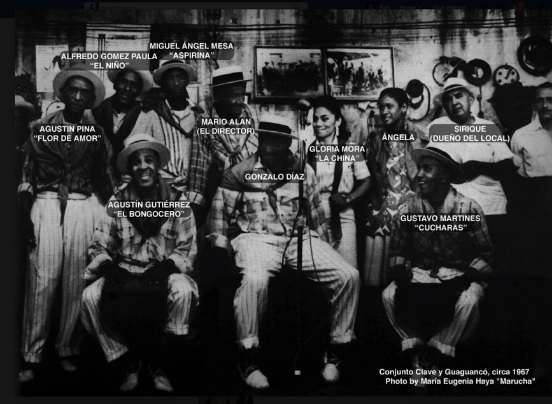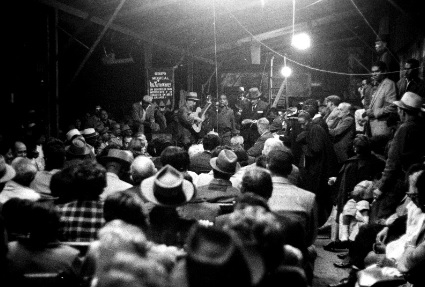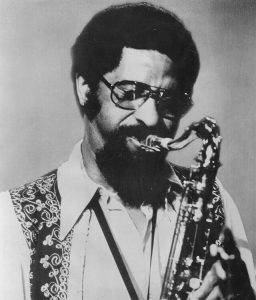Afro-Cuban culture, Blog, Cuba, Video and audio
A scene from the movie “Cuba Feliz”
If you don’t speak Spanish and the subtitles aren’t working and you’d like to see what they are singing, you can click on the upper left hand corner of the video and be taken to YouTube to see a subtitled version. (But remember to come back!)
Seventy-six-year-old Cuban street musician Miguel Del Morales, known as El Gallo (The Rooster), travels around Cuba with his guitar, making music in the homes of friends, in bars, and on street corners, in courtyards and stairwells. His rich voice, colored by a lifetime of cigarettes and rum, weathered by the sun and rain, bespeaks the joys and sufferings of his countrymen. An urban troubadour, Del Morales has been called “a living memory of Cuban bolero.”
At one point, he visits a Changüí party.
Here’s some info from wikipedia about Changüí:
Changüí is a style of Cuban music which originated in the early 19th century in the eastern region of Guantánamo Province, specifically Baracoa. It arose in the sugar cane refineries and in the rural communities populated by slaves. Changüí combines the structure and elements of Spain’s canción and the Spanish guitar with African rhythms and percussion instruments of Bantu origin. Changüí is considered a predecessor of son montuno (the ancestor of modern salsa), which has enjoyed tremendous popularity in Cuba throughout the 20th century.
Changüí is related to the other regional genres of nengón and kiribá and is descended from nengón. Technically, the changüi ensemble consists of: marímbula, bongos, tres, güiro (or guayo) and one or more singers.[ Changüi does not use the Cuban key pattern (or guide pattern) known as clave.The tres typically plays offbeat guajeos (ostinatos), while the guayo plays on the beat.
– Ken McCarthy
Jazz on the Tube
P.S. Our unique programming is made possible by help from people like you. Learn how you can contribute to our efforts here: Support Jazz on the Tube
Thanks.
Go to Cuba with Jazz on the Tube as your guide:
Click here for details
Afro-Cuban culture, Cuba, Video and audio
Conjunto Clave y Guaguancó
An excerpt from the documentary “La Herrería de Sirique” about blacksmith shop/performance space that flourished in Havana in the 1960s until it was closed down in 1968.
Born in 1939 in Caibarién, Cuba, the director of “La Herrería de Sirique” Héctor Veitía graduated from the University of Havana in Cuban studies and began his film career as an assistant director in 1961, directing his first documentary in 1963.
After years of documentary filmmaking, in 1990 Veitía became head of the International Workshops of the International School of Cinema and Television of San Antonio de los Baños in Cuba.

From the series shot at Sirique’s blacksmith workshop, January 1967,
by Ernesto Fernández
Courtesy Ernesto Fernández
 We found this photo with annotations on the outstanding Facebook page of percussionist Mark Sanders
We found this photo with annotations on the outstanding Facebook page of percussionist Mark Sanders
– Ken McCarthy
Jazz on the Tube
P.S. Our unique programming is made possible by help from people like you. Learn how you can contribute to our efforts here: Support Jazz on the Tube
Thanks.
Go to Cuba with Jazz on the Tube as your guide:
Click here for details
Afro-Cuban culture, Cuba, Video and audio
A herrería is a blacksmith shop and “La Herrería de Sirique” is about a Havana blacksmith who loved music.
Blacksmith by day, musician and music lover Alfredo González Suazo — better known as Sirique — ran one of the most important spaces for Cuban music in 1960s Havana in his blacksmithing shop.
Before the shop and its music program closed in 1968, it was documented in the film “La Herrería de Sirique” by Héctor Veitía.

From the series shot at Sirique’s blacksmith workshop, January 1967,
by Ernesto Fernández
Courtesy Ernesto Fernández
– Ken McCarthy
Jazz on the Tube
P.S. Our unique programming is made possible by help from people like you. Learn how you can contribute to our efforts here: Support Jazz on the Tube
Thanks.
Go to Cuba with Jazz on the Tube as your guide:
Click here for details
Afro-Cuban culture, Cuba, Video and audio
“Al Compas de Cuba” is a survey of essential roots Cuban music released as a documentary in 1960.
It’s attributed Mario Gallo. What’s strange about this attribution is that the Italian-born Argentinian Maria Gallo was born in 1878, died in 1945 and his last film was made in 1919.
The titles are written in Italian and the surnames of some of those credited with the production are Italian. (If anyone can clear up the mystery of how a man who died in 1945 directed a documentary that was released in 1960, please let us know.)
It looks like it was shot MOS (without sound) which means a sound track would have been added after the shooting. Fifteen or more years after the shooting? Inquiring minds want to know.
Musical forms developed in Cuba displayed in this film are:
Danzon, Rumba, Regla de Ocha (Santeria) and Abakuá.
The narration is in Spanish.
The first piece is a Danzon. Note the European kettle drum sneaking in some Afro-Cuban rhythms. Also note the movement of the dancers: European on the top and African below.
You can still hear the danzon performed for dancers in public outdoor settings in Mexican cities like Merida and Veracruz, two places that had a lot of contact with Cuba.
Next rumba.
Then a segment of a Santeria service.
Finally, the music of the Abakuá secret society.
– Ken McCarthy
Jazz on the Tube
P.S. Our unique programming is made possible by help from people like you. Learn how you can contribute to our efforts here: Support Jazz on the Tube
Thanks.
Go to Cuba with Jazz on the Tube as your guide:
Click here for details
Afro-Cuban culture, Blog, Cuba, Travel to Cuba, Video and audio
Not all the music in Cuba is in formal venues.
A few blocks from where I was staying I came across this band.
They got together to accompany an outdoor basketball tournament taking place in in public park.
In the last video the guys identify themselves and the name of the band.
A Saturday morning surprise on Calle 23 in Vedado
Note the little kids watching. This is how the music gets transmitted to the next generation.
Snare, bass drum, trumpet, cow bell. These guys would be at home in New Orleans. Was this one of the sounds of Congo Square?
On days like this, I wish my Spanish was better
These videos are just the tip of the tip of the iceberg of what I saw and heard in Havana. Over the ten days there I went to at least two different shows, some days as many as five, per day.
I could have easily gone to more and I never saw a bad one.
– Ken McCarthy
Jazz on the Tube
P.S. Our unique programming is made possible by help from people like you. Learn how you can contribute to our efforts here: Support Jazz on the Tube
Thanks.
Go to Cuba with Jazz on the Tube as your guide:
Click here for details
Afro-Cuban culture, Blog, Cuba, Festivals, Video, Video and audio
If you’re looking for a great time to visit Havana, keep your eyes open for the Fiesta del Tambor which takes place every March.
This festival literally offers more music at more locations than any mere mortal could possibly absorb.
I focused on three of the five venues, all of which are relatively close to each other: The Riviera Hotel (you’ve seen fragments of some of the jazz sessions there), Teatro Malla and Jardin de Teatro Malla.
The first four videos are from the Jardin (the garden.)
The last one is from a stage show inside the theater.
Proyecto Mujeres de la Rumba takes the stage.
In Cuba it’s not a surprise to see an audience member join in with complete knowledge of the moves and songs.
Los Papines, a decades old rumba group in its latest form
More from Los Papines
In Cuba, everybody dances: Alain Perez and friends
Keep in mind there was a different stage show at the Mella every night of the Festival and two rumba groups in the garden afterwards every night.
In spite of these musical riches, not everything interesting took place in a theater or garden or as part of the Festival.
Here’s what I stumbled across at a kid’s basketball tournament.
– Ken McCarthy
Jazz on the Tube
P.S. Our unique programming is made possible by help from people like you. Learn how you can contribute to our efforts here: Support Jazz on the Tube
Thanks.


 We found this photo with annotations on the outstanding
We found this photo with annotations on the outstanding 

